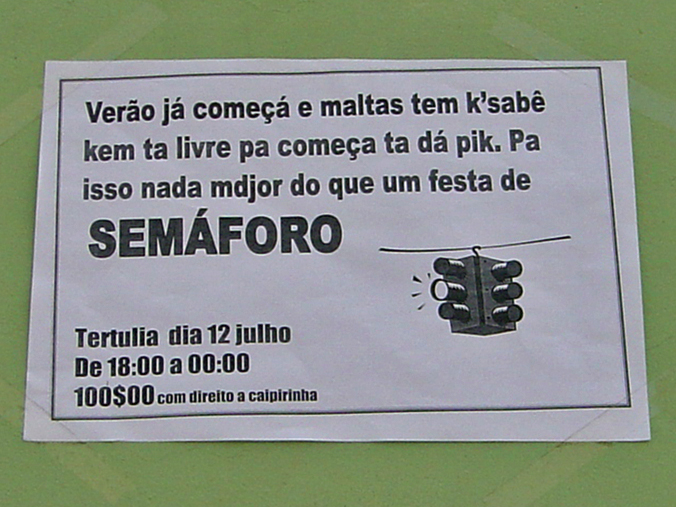|
Fogo Creole
Fogo Creole is the name given to the variant of Cape Verdean Creole spoken mainly in the Fogo of Cape Verde. It has around 50,000 speakers or nearly 5% of Cape Verdean Creole speakers including the diaspora's second language speakers. It belongs to the Sotavento Creoles branch. The rankings of this form of Cape Verdean Creole is fourth after Santo Antão and ahead of Sal. Characteristics Besides the main characteristics of Sotavento Creoles Cape Verdean Creole is a Portuguese-based creole language spoken on the islands of Cape Verde. It is also called or by its native speakers. It is the native creole language of virtually all Cape Verdeans and is used as a second language by t ... the Fogo Creole has also the following ones: * The progressive aspect of the present is formed by putting ''stâ'' before the verbs: ''stâ'' + V. * The sound that originates from Portuguese (written ''ão'') is represented by instead of . Ex. ''coraçã'' instead of ''coraçõ'' “hear ... [...More Info...] [...Related Items...] OR: [Wikipedia] [Google] [Baidu] |
Cape Verdean Creole
Cape Verdean Creole is a Portuguese-based creole languages, Portuguese-based creole language spoken on the islands of Cape Verde. It is also called or by its native speakers. It is the native creole language of virtually all Cape Verdeans and is used as a second language by the Cape Verdean diaspora. The creole has particular importance for creolistics studies since it is the oldest living creole. It is the most widely spoken Portuguese-based creole language. Name The formal designation of this creole is Cape Verdean Creole, but in everyday usage the creole is simply called ('Creole') by its speakers. The names Cape Verdean ( in Portuguese, in Cape Verdean Creole) and Cape Verdean language ( in Portuguese, in the Sotavento dialect of Cape Verdean Creole and in the Barlavento Islands, Barlavento dialect) have been proposed for whenever the creole will be standardized. Origins The history of Cape Verdean Creole is hard to trace due to a lack of written documentation ... [...More Info...] [...Related Items...] OR: [Wikipedia] [Google] [Baidu] |
Fogo, Cape Verde
Fogo (Portuguese for "fire") is an island in the Sotavento group of Cape Verde. Its population is 35,837 (2015),Cabo Verde, Statistical Yearbook 2015 Instituto Nacional de Estatística with an area of 476 km2. It reaches the highest altitude of all the islands in Cape Verde, rising to at the summit of its active volcano, |
Cape Verde
, national_anthem = () , official_languages = Portuguese , national_languages = Cape Verdean Creole , capital = Praia , coordinates = , largest_city = capital , demonym = Cape Verdean or Cabo Verdean , ethnic_groups_year = 2017 , government_type = Unitary semi-presidential republic , leader_title1 = President , leader_name1 = José Maria Neves , leader_title2 = Prime Minister , leader_name2 = Ulisses Correia e Silva , legislature = National Assembly , area_rank = 166th , area_km2 = 4033 , area_sq_mi = 1,557 , percent_water = negligible , population_census = 561,901 , population_census_rank = 172nd , population_census_year = 2021 , population_density_km2 = 123.7 , population_density_sq_mi = 325.0 , population_density_rank = 89th , GDP_PPP ... [...More Info...] [...Related Items...] OR: [Wikipedia] [Google] [Baidu] |
Sotavento Creoles
Cape Verdean Creole is a Portuguese-based creole language spoken on the islands of Cape Verde. It is also called or by its native speakers. It is the native creole language of virtually all Cape Verdeans and is used as a second language by the Cape Verdean diaspora. The creole has particular importance for creolistics studies since it is the oldest living creole. It is the most widely spoken Portuguese-based creole language. Name The formal designation of this creole is Cape Verdean Creole, but in everyday usage the creole is simply called ('Creole') by its speakers. The names Cape Verdean ( in Portuguese, in Cape Verdean Creole) and Cape Verdean language ( in Portuguese, in the Sotavento dialect of Cape Verdean Creole and in the Barlavento dialect) have been proposed for whenever the creole will be standardized. Origins The history of Cape Verdean Creole is hard to trace due to a lack of written documentation and to ostracism during the Portuguese administration ... [...More Info...] [...Related Items...] OR: [Wikipedia] [Google] [Baidu] |
Santo Antão, Cape Verde
Santo Antão (Portuguese for " Saint Anthony") is the westernmost island of Cape Verde. At , it is the largest of the Barlavento Islands group, and the second largest island of Cape Verde.Cabo Verde, Statistical Yearbook 2015 Instituto Nacional de Estatística The nearest island is São Vicente to the southeast, separated by the sea channel Canal de São Vicente. Its population was 38,200 in mid 2019, [...More Info...] [...Related Items...] OR: [Wikipedia] [Google] [Baidu] |
Sal, Cape Verde
Sal (Portuguese for "salt") is an island in Cape Verde. Sal is a tourist destination with white sandy beaches and over 350 days of sunshine a year. It is one of the three sandy eastern islands of the Cape Verde archipelago in the central Atlantic Ocean, off the west coast of Africa. Cabo Verde is known for year-round kiteboarding, for the large reserve of Caretta turtles which hatch from July to September, and the music of Cesaria Evora. History For Europeans , the island was discovered on 3 December 1460 and named ''Llana'' ("flat"). This name was changed into the current "Sal" when the two large salt ponds (Pedra de Lume and Santa Maria) were discovered. The first three centuries after its discovery, the island was only sparsely inhabited; in 1720 there was a small fishing village near present Palmeira. This changed when the salt industry was developed at the end of the 18th century, starting in Pedra de Lume. Santa Maria was founded in the south of the island in 1830 by ... [...More Info...] [...Related Items...] OR: [Wikipedia] [Google] [Baidu] |

